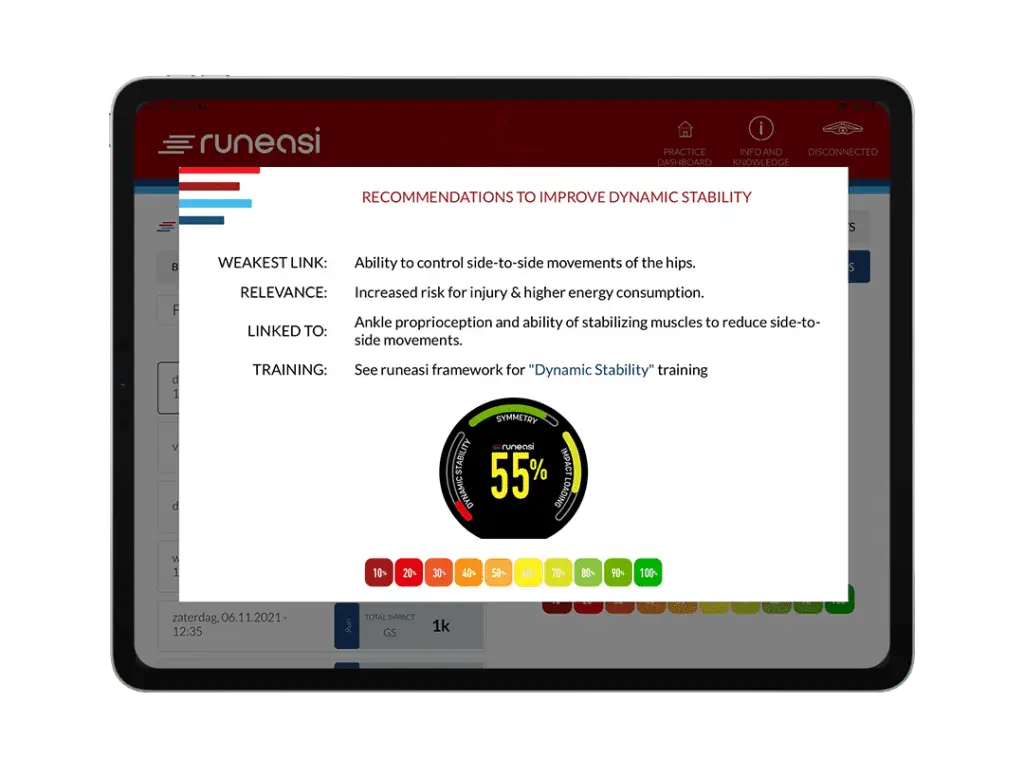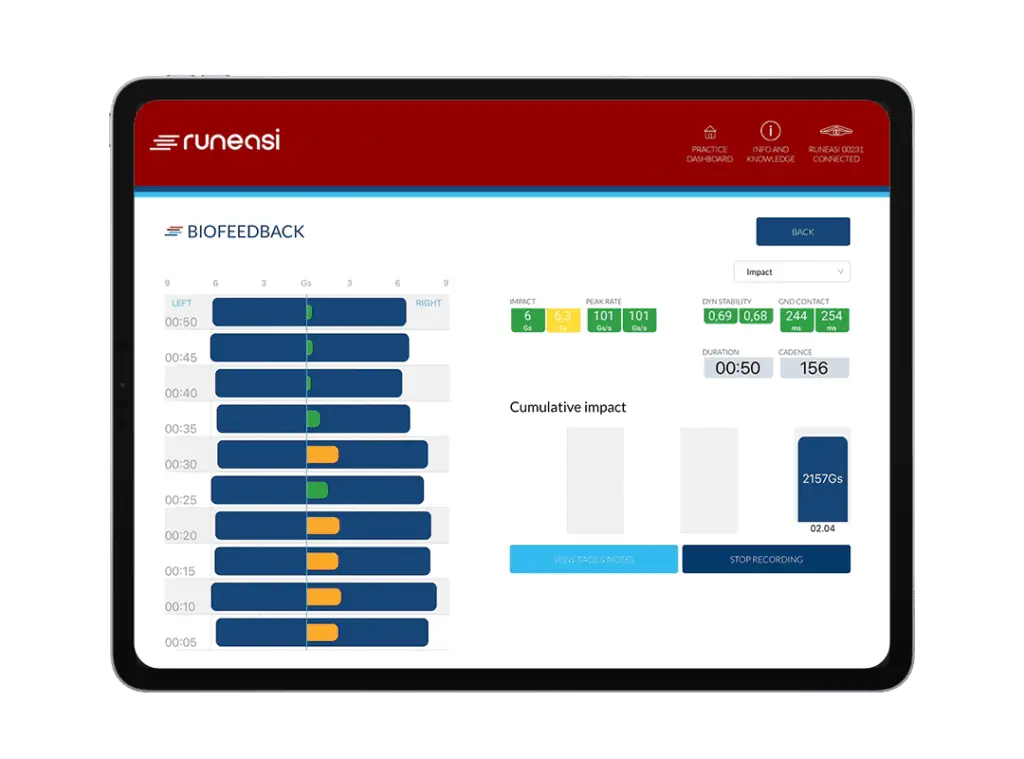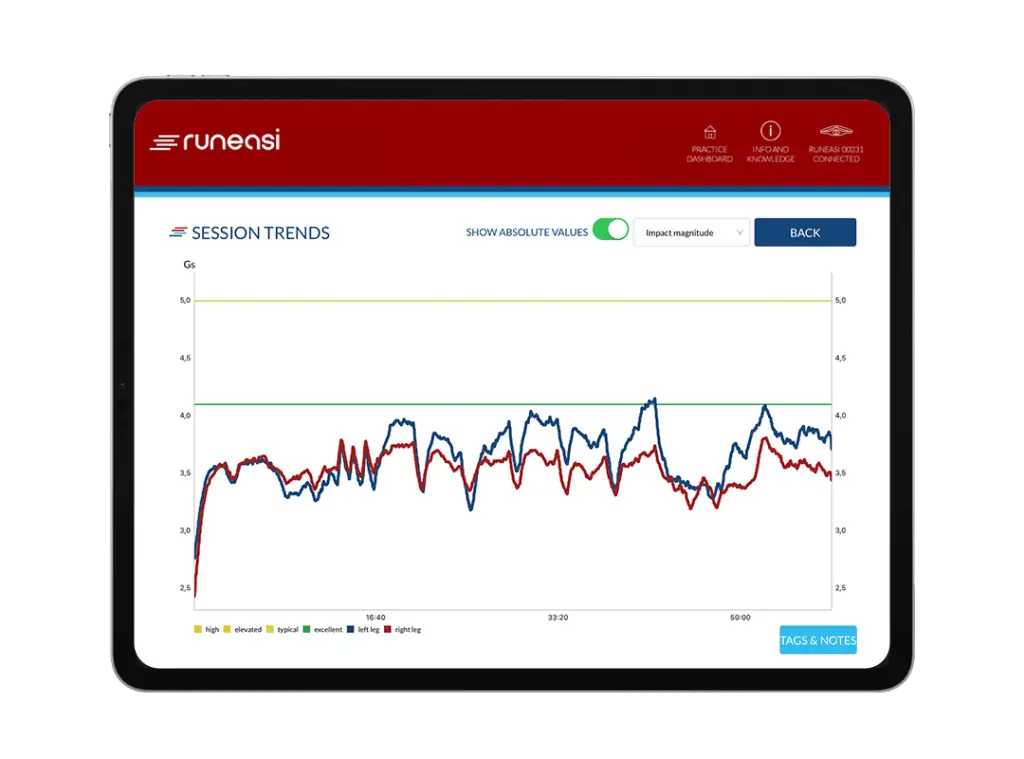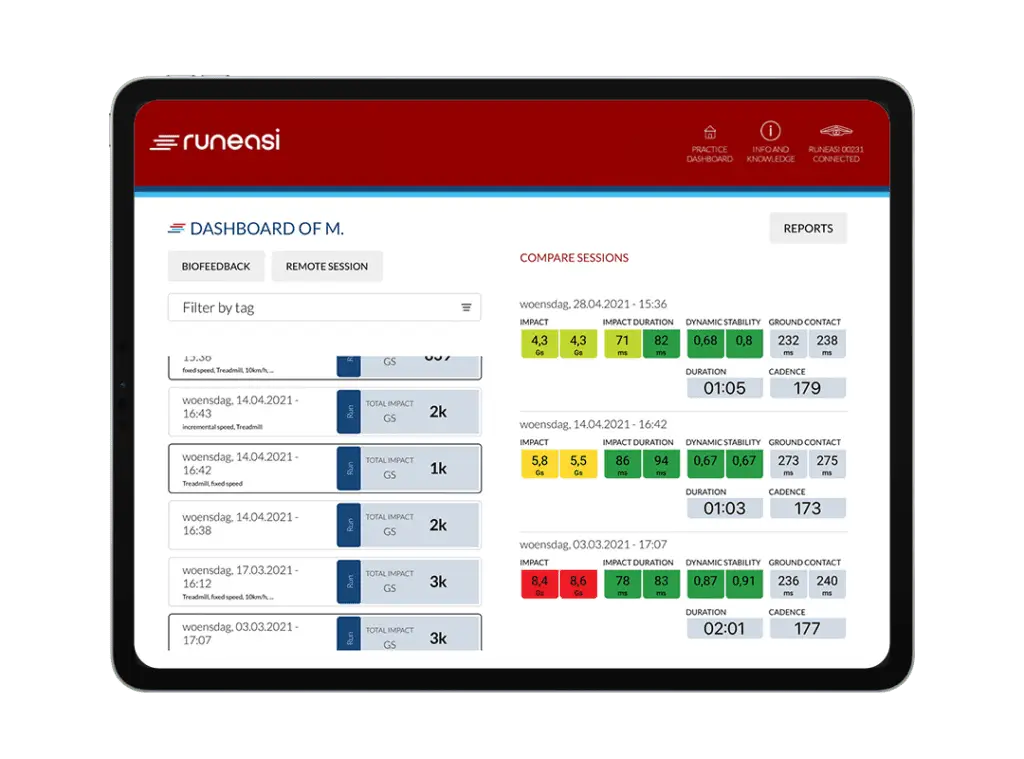How to improve your dynamic stability symmetry?
This section highlights how to improve your dynamic stability using specific exercises. If you want a deeper understanding of what dynamic stability is and why it matters, you can explore our dedicated article.
Dynamic stability is largely determined by the strength and coordination of your stabilizing muscles (primarily the abs, back, and glutes). These muscles work together to control movement and maintain alignment while you run. Left-to-right imbalances in dynamic stability often stem from weakness or poor activation in these stabilizers.

Beyond improving movement mechanics, dynamic stability training is an excellent way to strengthen and rewire the muscles that stabilize your hips while running. Through a progressive series of exercises, you can build strength from isolated movements to more dynamic, full-body actions, helping you feel more stable and controlled during your runs. Paying extra attention to your weaker side during these exercises helps restore balance in the stabilizing muscles.
Training plan for dynamic stability

This training plan includes three progressive phases, each focusing on different exercise types. Phase 1 emphasizes isolated and static exercises to develop strength and endurance in the stabilizing muscles. Phases 2 and 3 introduce more dynamic and reactive movements that improve muscle coordination and functional stability.
By combining both isolated/static (strength-focused) and dynamic/reactive (functional) exercises, you can build a stronger, more balanced body and become a more efficient runner. Mix up your workouts and enjoy the benefits of a varied, purposeful training program!
- Goal phase 1: Enhance strength capacity of stabilizing muscles.
- Focus: Isolated muscle work and static stability.
Exercise 1 - Flexibility warm-up
3 x 8 reps (both sides) – Rest 15 sec
Strive for a 90° angle in both your knees and hips. Use your arms to maintain your trunk position.
Hip range of motion
3 x 5 reps (both sides) – Rest 15 sec
Reach towards your feet.
Hip range of motion
3 x 8 reps (both sides) – Rest 15 sec
Rotate a circle with your leg.
Hip range of motion
Exercise 2 - Hip-focused strength
3 x 8 reps – Rest 15 sec (between each side)
Keep your hips tight while opening them like a clam shell.
Hip-focused muscle work
3 x 8 reps – Rest 15 sec (between each side)
Keep your hips high while opening them like a clam shell.
Hip-focused muscle work
3 x 8 reps – Rest 15 sec (between each side)
Hold your hips high in line with your upper body.
Hip-focused muscle work
Exercise 3 - Abdominal-focused Strength
4 x 15 sec hold – Rest 15 sec
Keep your lower back slightly to the ground, and keep breathing during the exercise.
Abdominal-focused muscle work
3 x 8 reps (both sides alternating) – Rest 30 sec
Keep your lower back slightly to the ground, and keep breathing during the exercise.
Abdominal-focused muscle work
3 x 5 reps – Rest 30 sec
Keep your lower back slightly to the ground, and keep breathing during the exercise.
Abdominal-focused muscle work
Exercise 4 - Hip-focused control
3 x 10 reps – Rest 30 sec (small weight 1-3kg)
Try to hold a steady position while executing the movement.
Hip-focused static exercise
3 x 8 reps – Rest 30 sec (small weight 1-3kg)
Try to hold a steady position while executing the overhead movement.
Hip-focused static exercise
3 x 6 reps – Rest 30 sec (small weight 3-5kg)
Look in the direction of the weight push.
Hip-focused static exercise
Exercise 5 - Abdominal-focused control
4 x 20 sec hold – Rest 40 sec
Align your body and hold this position. Keep breathing during the exercise.
Abdominal-focused static exercise
3 x 8 reps – Rest 45 sec
Make a sideways 8-loop with the Swiss ball while maintaining form.
Abdominal-focused static exercise
3 x 5 reps (each side) – Rest 1 min
Hold alignment while skipping. Hold for 1 second afterward.
Abdominal-focused static exercise
- Goal phase 2: Enhance stabilizing muscle coordination.
- Focus: Dynamic stability exercises.
Exercise 1 - Flexibility warm-up
3 x 8 reps (both sides) – Rest 15 sec
Strive for a 90° angle in both your knees and hips. Use your arms to maintain your trunk position.
Hip range of motion
3 x 5 reps (both sides) – Rest 15 sec
Reach towards your feet.
Hip range of motion
3 x 8 reps (both sides) – Rest 15 sec
Rotate a circle with your leg.
Hip range of motion
Exercise 2 - Hip-focused control
3 x 8 reps (each side) – Rest 30 sec (small weight 1-3kg)
Try to hold a steady position while executing the overhead movement.
Hip-focused static exercise
3 x 6 reps (each side) – Rest 30 sec (small weight 3-5kg)
Look in the direction of the weight push.
Hip-focused static exercise
3 x 6 reps (each side) – Rest 30 sec ( 3-8kg)
Try to hold a steady position while executing the swings.
Hip-focused static exercise
Exercise 3 - Abdominal-focused control
3 x 8 reps – Rest 45 sec
Make a sideways 8-loop with the Swiss ball while maintaining form.
Abdominal-focused static exercise
3 x 5 reps (each side) – Rest 1 min
Hold alignment while skipping. Hold for 1 second afterward.
Abdominal-focused static exercise
3 x 5 reps (each side) – Rest 1 min
Attack the wall.
Abdominal-focused static exercise
Exercise 4 - Dynamic stability
3 x 8 reps (both sides) – Rest 30″ after each side
Strive for a 90° angle in both your knees and hips.
Dynamic stability exercise
3 x 5 reps (both sides) – Rest 30″ after each side
Strive for a 90° angle in both your knees and hips.
Dynamic stability exercise
3 x 5 reps (both sides) – Rest 30″ after each side
Look in the direction of your ball throw.
Dynamic stability exercise
Exercise 5 - Dynamic stability
3 x 8 reps (both sides) – Rest 30″ between each side
Touch the floor briefly with your heel.
Dynamic stability exercise
3 x 8 reps (both sides) – Rest 30″ between each side
Touch the floor briefly with your heel while rotating inward.
Dynamic stability exercise
3 x 8 reps (both sides) – Rest 30″
Touch the floor briefly with your heel while rotating inward.
Dynamic stability exercise
Exercise 6 - Dynamic stability drill
4 x 10m – Rest walk back
Lift your knee high while maintaining an upright posture.
Dynamic stability drill
4 x 15m – Rest walk back
Strive for 90° degrees in both hips and knees.
Dynamic stability drill
4 x 15m – Rest walk back (Small weight 3-5kg)
Strive for 90° degrees in both hips and knees. Look in the direction of your rotation.
Dynamic stability drill
- Goal phase 3: Enhance reactive stabilization.
- Focus: Reactive stability exercises.
Exercise 1 - Flexibility warm-up
3 x 8 reps (both sides) – Rest 15 sec
Strive for a 90° angle in both your knees and hips. Use your arms to maintain your trunk position.
Hip range of motion
3 x 5 reps (both sides) – Rest 15 sec
Reach towards your feet.
Hip range of motion
3 x 8 reps (both sides) – Rest 15 sec
Rotate a circle with your leg.
Hip range of motion
Exercise 2 - Dynamic stability
3 x 5 reps (both sides) – Rest 1min
Strive for a 90° angle in both your knees and hips.
Dynamic stability exercise
3 x 5 reps (both sides) – Rest 30″ after each side
Look in the direction of your ball throw.
Dynamic stability exercise
3 x 5 reps (both sides) – Rest 30″ after each side
Look in the direction of your rotation.
Dynamic stability exercise
Exercise 3 - reactive stability
4 x 10 sec (each side) – Rest 15″ after each side
Keep your feet quick and your upper body steady.
Reactive stability
4 x 10 sec (each side) – Rest 15″ after each side
Keep your feet quick and your upper body steady.
Reactive stability
4 x 10 sec (each side) – Rest 15″ after each side
Keep your feet quick and your upper body steady.
Reactive stability
Exercise 4 - reactive stability
3 x 5 reps (both sides) – Rest 45″
Land steadily and hold for one second to ensure stability.
Reactive stability
3 x 5 reps (both sides) – Rest 45″ (3-5kg)
Land steadily and hold for one second to ensure stability.
Reactive stability
4 x 10 sec – Rest 30″ (weight 3-5kg)
Look in the direction of your rotation.
Reactive stability







